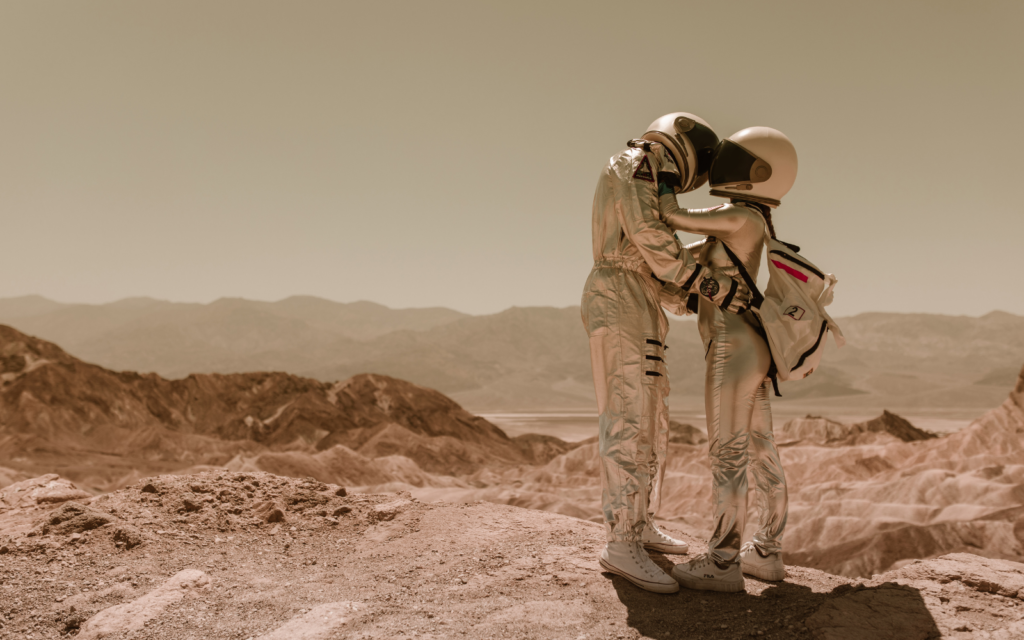A new dawn of space exploration is upon us. NASA aims to land the first woman and person of colour on the moon by the end of 2025, and send a crew on a year-and-a-half long mission to Mars in the 2030s.
To ensure a safe and pleasurable journey to the final frontier, national agencies such as NASA and private companies such as SpaceX must address both the technical and human factors associated with working and living in space. Yet, the realities of sexuality and intimacy in space are mostly omitted.
How will people be able to live for prolonged periods of time in the isolated, confined and extreme conditions of spacecrafts and other planets? How will people navigate falling in love, having sex and beginning and ending relationships under such conditions? How will people deal with the stress, limited choice of intimate partners and issues related to consent? And how will sexual harassment or assault be prevented or addressed?
On Oct. 15, 2017, #MeToo ushered in a global movement against sexual harassment and assault. As researchers exploring human factors in space and space sexology — the study of intimacy and sexuality away from Earth — we argue that it is time to plan for the future of #MeToo in space.
Sexual assault and space research
On Dec. 3, 1999, Judith Lapierre, a Canadian nurse and social medicine researcher, embarked on a 110-day Mars simulation experiment aboard a Mir Space Station replica in Moscow. Lapierre was the only woman in an eight-member crew.
One month into the study, the Russian chief commander discussed running an experiment where Lapierre would be treated as the crew’s sexual object. On New Year’s Eve, he stated it was time to “do the experiment,” and forcibly grabbed and kissed Lapierre despite her repeated requests to stop.
Lapierre notified the Canadian Space Agency and informed her Austrian crew commander, who immediately demanded action from the local and international management.
When interviewed by the media after the experiment, Lapierre opened up about her expectations of a safe, harassment-free and violence-free working environment. Yet some Russian news outlets blamed and misrepresented her as depressed and the cause of unrelated problems, including a physical altercation between Russian crew members.
The aggression during the simulation experiment were reduced to cultural differences. And since then, Lapierre’s time in the space sector became an uphill battle because she spoke out.
As she describes in Rudolph and Werner Herzog’s 2022 film Last Exit: Space:
“When that mission finished, it really influenced my whole career because I thought this would be the start of my research project with the space agency or the start of my field of work, but I was just totally pushed out of the system.”
Other research contexts
Lapierre is not alone. Sexual harassment has also happened in other contexts similar to the extreme conditions of actual and simulated space environments.
A 2022 report commissioned by the National Science Foundation (NSF) showed that out of the 290 female respondents, 72 per cent and 47 per cent agreed that sexual harassment and sexual assault, respectively, are a problem in the United States Antarctic Program (USAP). As one of the survivors reported:
“I know none of this is news to you, it’s just a known fact around station. It’s so self-evident that [it’s] barely worth speaking out loud. [Sexual assault and sexual harassment] are a fact of life [here], just like the fact that Antarctica is cold and the wind blows.”
The NSF report highlights the lack of adequate prevention, reporting and response systems, as well as the lack of support for victim-survivors and the lack of trust in human resources and USAP leadership. And only a minority of the leadership agreed that sexual harassment (40 per cent) and sexual assault (23 per cent) are a problem in the USAP.
This is not limited to the USAP. In 2021, employees of the aerospace companies Blue Origin and SpaceX came forward with an alarming array of sexual harassment and misconduct allegations.
In an open essay, a group of 21 current and former employees of Blue Origin denounced a sexist work culture, inappropriate behaviours toward women and cases of sexual harassment by senior leaders.
No end in sight?
For humankind to safely take its next steps into the universe, the culture of space exploration must change.
These harrowing events call for national agencies and private space companies to adopt a proactive stance against sexual harassment and assault. NASA and other space organizations must go beyond implementing basic anti-harassment policies. They must devote the necessary resources to put in place proper prevention, reporting and response infrastructures, including the support and protection of victim-survivors.
This may include the creation of separate oversight entities composed of sexologists and qualified health and psychosocial professionals. This may also include investing in the study of human relationships and sexual health in space.
Victim-survivors need to be part of the conversation and solutions, every step of the way. This is essential to ensure the safety of Earth-based and space environments, and ethically conduct much-needed scientific research on human spacelife.
MeToo taught us that collective action is powerful. And in the words of Lapierre:
“It is time, more than ever, to meet the real challenges of space exploration, with honesty, transparency, and by recognizing that Earth’s unacceptable behaviors are also Space’s unacceptable behaviors for a spacefaring civilization.
- is a PhD Candidate, Psychology of Human Sexuality, Erotic Technology & Space Sexology, Concordia University
- is a Professor, Nursing Science, Université Laval
- is a Postdoc Research Fellow, Kinsey Institute, Indiana University
- This article first appeared on The Conversation




